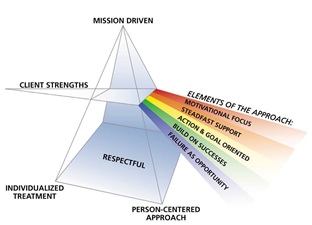PRISMMODEL®
The PRISMMODEL® for the Effective Treatment of Serious and Persistent Mental Illness defines FHR's clinical approach to service. As such, the PRISMMODEL represents an agency-wide training effort. It is our intent that all employees become proficient in the PRISMMODEL to ensure that our organization's mission, vision, and guiding beliefs come to life each day within our clinical practice.

Person-Centered
Person-centeredness begins with the basic and fundamental tenet that recognizes the humanity and dignity of individuals with mental illness. Person-centeredness assumes the inherent individuality and goodness of all people, continually questions and investigates client wishes and goals, and positively guides individuals through the peaks and valleys of the recovery process. The Treatment Plan serves as the therapeutic contract with the client. It clearly reflects his or her needs and preferences, and maximizes the use of each client's unique strengths.
Respectful
Consistency and trust are essential qualities within the strengths-based relationship. Within the PRISMMODEL, these relationship characteristics are developed from a foundation of respect: Respect for the individual as a human being; respect for the individual’s wishes, preferences, and desires; and respect for apprehensions, fears, and barriers. This foundation of respect is essential to assist individuals in articulating, claiming, and owning their goals, to persevere when barriers emerge, and to continually strive to reach their full human potential.
Individualized
The PRISMMODEL views individuality as the pinnacle of the treatment process. Approaches and interventions are customized and varied, depending on each client's strengths, challenges, and environmental situation. The approach is designed to meet the unique needs of each client through an engaged and persistent approach.
Strengths-Based
The PRISMMODEL emphasizes the full and continued assessment of a client's strengths, including character and personality attributes, intellectual and cognitive capacities, artistic talents, educational and vocational preferences and accomplishments, social and interpersonal abilities, cultural interests and spiritual beliefs, familial support, connectedness to friends and acquaintances, and practical skills. This approach effectively re-frames “failures” into learning experiences for clients who are being served.
Mission Driven
The fifth and final core element of FHR's PRISMMODEL highlights the relationship between the organizational mission and actual service delivery. The core constructs within the organization’s mission, specifically its emphasis on personal investment, perseverance, and hope, along with the five core elements of the PRISMMODEL, are entrenched within the Model’s primary phases of treatment: Engagement, Assessment, and Treatment Planning. Together, they guide service provision in a way that truly recognizes and respects the "client voice" within the recovery model.
Phases of Treatment:
Module I - Engagement
Module I highlights the relationship-building techniques that are essential for establishing a successful therapeutic rapport with the consumer. The building of this trusting relationship is the foundation of an effective recovery model.
Engagement highlights:
- The role of an effective helper.
- The importance of a strengths-based and person-centered referral and orientation process.
- Communication techniques to help ensure a positive first contact and first face-to-face meeting with the consumer.
- The importance of staff support to the successful integration of the consumer into the treatment team.
Module II - Assessment
A successful assessment process is essential to providing the consumer with effective and informed treatment. During the Assessment phase, the "helper" gathers information from the consumer on a wide variety of life experiences. This multi-dimensional approach affords the "helper" the opportunity to assess the consumer's self-perceptions of key attributes, along with areas in need of improvement.
- Give attention to the whole person.
- Identify a consumer's strengths.
- Be a reflective practitioner.
- Be flexible with your methods of data collecting.
- Exercise good writing skills.
These skills will be used to meet the consumer where they are at, to create for the consumer a new history and recovery-oriented future, to employ a strengths perspective during assessment, and to work as a team with the consumer and other "helpers" toward the ultimate goal of recovery.
Module III - Treatment Planning
- In accordance with the PRISMMODEL, the foundation for treatment plans is that of individual choice.
- The Treatment Plan is a written action plan that identifies the consumer's areas of need, treatment goals, and desires, as well as the criteria to determine achievement of the identified goals.
- The Treatment Plan reflects the written covenant among the partners in treatment: consumer, counselor, family, and those considered important in the consumer's life.
- The Treatment Plan is person-centered and is framed around identified goals that a consumer would like to work towards and achieve.
